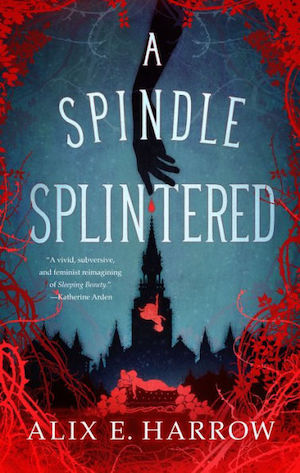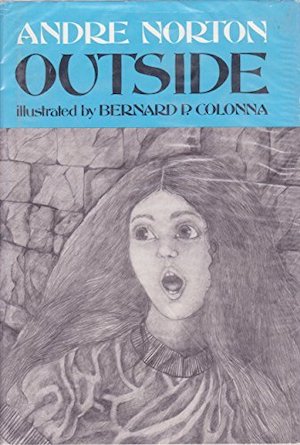Outside is amazingly topical for a short work written apparently for younger readers sometime before 1974. The illustrations by Bernard Colonna are lovely and oh so Seventies. I particularly admire the brother, who is around age 18, but is portrayed with Peter Max hair and a handsome porn ‘stache.
The story is told from the point of view of his nine-year-old sister, Kristie. Kristie and Lew live in a domed city. The world outside is an uninhabitable wasteland. The city inside is rapidly devolving into a similar state.
All the adults have died of a plague. Teenagers are in charge. There are no babies, which is very younger-reader and very Norton.
Kristie is obsessed with finding out whether the Outside is still as horrible as everyone has been taught, or if nature has healed itself. While she keeps trying to find ways out of the dome, her brother warns her against a dangerous intruder called the Rhyming Man. This being has been abducting children and causing them to disappear.
The plot proceeds in very predictable fashion, but about two-thirds of the way through it takes a sharp turn into the surreal. Kristie not only gets her wish, she discovers wonderful new mind powers and a community of children and teenaged girls who are just like her. There’s also teleportation and nasty mutant rats and some rather terrible poetry, though most of that is based on familiar children’s rhymes.
Buy the Book


A Spindle Splintered
The whole thing is a mashup of the Pied Piper story and a set of popular tropes of the time. The blasted Earth, the isolated city, the adults all killed off by a plague, the children surviving by looting and scavenging—it’s a Classic Trek plot and the plot of Logan’s Run and many a less illustrious work in film and print. What makes it work is Norton’s patented master-class pacing and her protagonist. Kristie has great charm, and she is absolutely set on getting Outside.
Also I had that fox plushie. He went to college with me. I wonder what ever happened to him?
It’s a really interesting read in this time of pandemic and rapidly escalating climate change. A pandemic that began by mostly killing the elderly, a planet half on fire—I could feel the world Kristie’s parents and presumably grandparents tried to protect themselves from by building the hermetically sealed cities. They’re a whole lot more proactive than anyone now seems to be, and I’m not sure how well nature can heal itself…unless we wall ourselves off like Norton’s cities. Nor am I convinced that we’ll discover amazing mind powers with the help of a handy AI.
But who knows? Norton certainly was prescient here. Maybe the rest will come true, too.
The next used-bookstore treasure is another work for younger readers, from all the way back in 1947: Rogue Reynard.
Judith Tarr has written novels than she can count, and a whole lot of shorter works, too. She lives in Arizona with a herd of Lipizzan horses, an assortment of cats, and a blue-eyed dog.











As I recall in the Seventies it was a new ice age we had to fear. Followed by acid rain and the ozone hole. We were all going to die of melanoma. In fact according to seventies predictions we’ve all been dead for a decade or so.
This story is an expansion of an earlier short story she wrote called “London Bridge” which was told from the point of view of the older brother. It’s interesting to read them together. I’d be curious to see your thoughts on the contrast.
Andre’s take on the Reynard the Fox tales makes me wonder if she didn’t inspire Disney to make Robin Hood with anthropomorphic animals? I realize there have been other stories retold for children with animal characters but this must be one of the earlier ones.
I just saw that William Nolan who co-authored LOGAN’S RUN died a few days ago. RIP, Mr. Nolan.
I’ve been listening to and reading “we are all going to die” scenarios for almost 70 years, and we keep escaping it. I hope we are as lucky/smart, this time, too.
Norton’s boy adventures from the worst of the Cold War to the Seventies and beyond to the fantasy disasters of other dimensions’ atrocities invading the Witch World seemed to inform most of Norton’s fiction. No wonder she was into underground adventures and mental escapes to other places that were much safer.
Oh, ecofiction, one of my favorites! Along the same lines: Austral, by Paul McAuley. Also with a female protagonist – the title is the name of a young woman, genetically modified to stand up to extreme cold for the early settlement of Antartctica. Except, the weather is warming up and this modification is not so critical anymore, regular humans can live there too. Very epic stuff.
The first book I ever read by Norton as a kid and it has large place in my heart. Although, as a kid reading it, I just kind of accepted Kristie’s world. It’s bad, and she wants something better. But, she’s not really afraid of her world. Sure, certain things scare her, like being caught in a part of the dome where the air recyclers have stopped working or being chased by rats, but these somehow didn’t seem any more terrifying than the things that were real in my nine or ten year old life that I sometimes found terrifying. The overall horror of and low chances of survival didn’t really hit me till years later.
Which doesn’t matter, because I still love it.
I think this is one of those books that intrigued me as a young reader and then I forgot it. A Harlequin guy appears? And yes, Star Trek had “Miri”, which they may have enjoyed making particularly since several children of cast members were on screen doing the urban “Lord of the Flies” stuff.